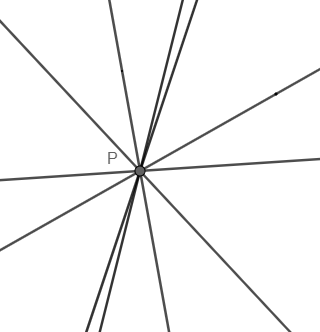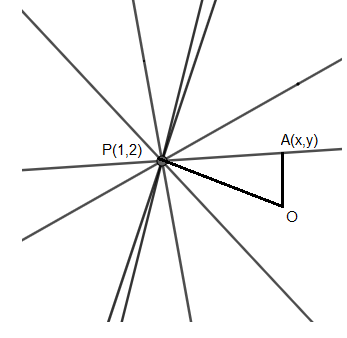Question
Question: The locus of the foot of the perpendicular from the origin on each member of the family \[(4a+3)x-(a...
The locus of the foot of the perpendicular from the origin on each member of the family (4a+3)x−(a+1)y−(2a+1)=0 is
(a). (2x−1)2+4(y+1)2=5
(b). (2x−1)2+(y+1)2=5
(c). (2x+1)2+4(y−1)2=5
(d). (2x−1)2+4(y−1)2=5
Solution
Hint:- In this question first we have to find the value of the point of intersection of the family of straight lines then apply Pythagoras theorem to get the required answer.
Complete step-by-step solution -
The equation of the family of lines is,
(4a+3)x−(a+1)y−(2a+1)=0
Expanding this, we get
4ax+3x−ay−y−2a−1=0
Now regrouping them, we get
3x−y−1+a(4x−y−2)=0
Now this is of the form L1+λL2=0.
Let the point of intersection of these two lines, i.e., 3x−y−1=0and 4x−y−2=0be P.
So, the given family of lines will pass through this fixed point P, as shown below.

Now we will find the coordinates of point P.
Consider,
3x−y−1=0
3x=y+1
x=3y+1........(i)
Substitute this value in other equation of line, we get
4x−y−2=0
4(3y+1)−y−2=0
34y+4−3y−(3×2)=0
y+4−6=0
y=6−4=2
Substituting the value of ‘y’ in equation (i), we get
x=32+1=33=1
So, the point of intersection of the family of lines is P(1,2).
Now, there is a perpendicular drawn from the origin onto each line. Let the foot of the perpendicular on each line be A(x,y), as shown below.

Now the points OPA will form a right-angled triangle in all the lines.
Applying Pythagoras theorem on ΔOPA, we get
OP2=OA2+AP2.........(ii)
We know the distance between points (x1,y1)and (x2,y2)is given by the distance formula, i.e.,
(x2−x1)2+(y2−y1)2
Applying the distance formula in equation (ii), we get
((1−0)2+(2−0)2)2=((x−0)2+(y−0)2)2+((x−1)2+(y−2)2)2
12+22=x2+y2+(x−1)2+(y−2)2
Expanding, we get
1+4=x2+y2+(x2+1−2x)+(y2+4−4y)
5=2x2+2y2+1−2x+4−4y
As this is not matching with the options, we will multiply the above equation with 2, we get
10=4x2+4y2+2−4x+8−8y
Grouping them, we get
4x2−4x+2+4y2−8y+8=10
Now we will try to convert this into (a+b)2form, as in options.
(4x2−4x+1)+1+4(y2−2y+1)+4=10
We know, (a2−2ab+b2)=(a+b)2, so above equation can be re-written as,
(2x−1)2+4(y−1)2=10−4−1
(2x−1)2+4(y−1)2=5
So, the locus of the foot of the perpendicular from the origin on each member of the family (4a+3)x−(a+1)y−(2a+1)=0 is (2x−1)2+4(y−1)2=5.
Hence, the correct answer is option (d).
Note: Another method to find the answer is, instead of using Pythagoras theorem; we can find the slope of the equation of perpendicular line from the origin to a point. Then applying the formula, y=mx+c. But this would be a lengthy process.
